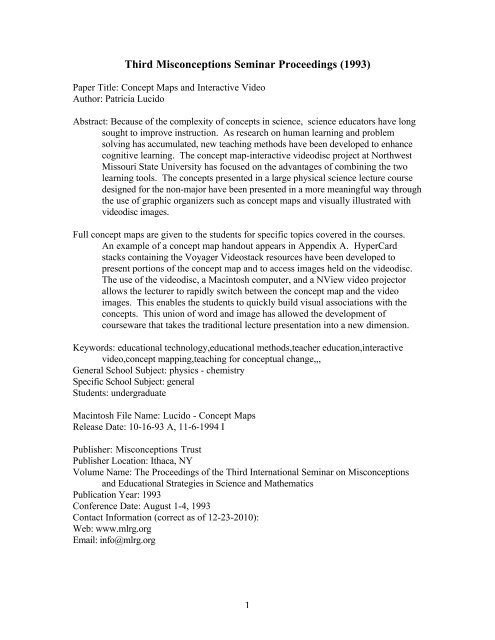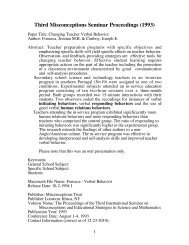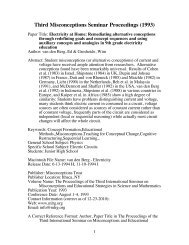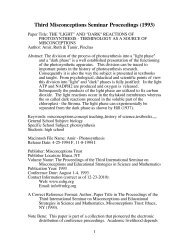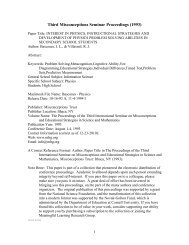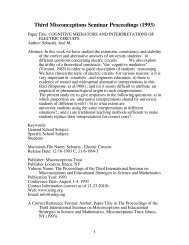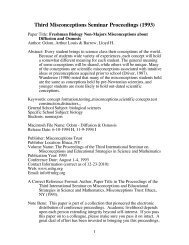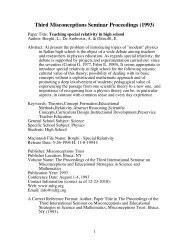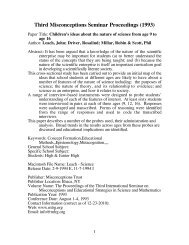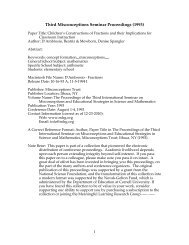Concept Maps and Interactive Video - Mlrg.org
Concept Maps and Interactive Video - Mlrg.org
Concept Maps and Interactive Video - Mlrg.org
Create successful ePaper yourself
Turn your PDF publications into a flip-book with our unique Google optimized e-Paper software.
Third Misconceptions Seminar Proceedings (1993)<br />
Paper Title: <strong>Concept</strong> <strong>Maps</strong> <strong>and</strong> <strong>Interactive</strong> <strong>Video</strong><br />
Author: Patricia Lucido<br />
Abstract: Because of the complexity of concepts in science, science educators have long<br />
sought to improve instruction. As research on human learning <strong>and</strong> problem<br />
solving has accumulated, new teaching methods have been developed to enhance<br />
cognitive learning. The concept map-interactive videodisc project at Northwest<br />
Missouri State University has focused on the advantages of combining the two<br />
learning tools. The concepts presented in a large physical science lecture course<br />
designed for the non-major have been presented in a more meaningful way through<br />
the use of graphic <strong>org</strong>anizers such as concept maps <strong>and</strong> visually illustrated with<br />
videodisc images.<br />
Full concept maps are given to the students for specific topics covered in the courses.<br />
An example of a concept map h<strong>and</strong>out appears in Appendix A. HyperCard<br />
stacks containing the Voyager <strong>Video</strong>stack resources have been developed to<br />
present portions of the concept map <strong>and</strong> to access images held on the videodisc.<br />
The use of the videodisc, a Macintosh computer, <strong>and</strong> a NView video projector<br />
allows the lecturer to rapidly switch between the concept map <strong>and</strong> the video<br />
images. This enables the students to quickly build visual associations with the<br />
concepts. This union of word <strong>and</strong> image has allowed the development of<br />
courseware that takes the traditional lecture presentation into a new dimension.<br />
Keywords: educational technology,educational methods,teacher education,interactive<br />
video,concept mapping,teaching for conceptual change,,,<br />
General School Subject: physics - chemistry<br />
Specific School Subject: general<br />
Students: undergraduate<br />
Macintosh File Name: Lucido - <strong>Concept</strong> <strong>Maps</strong><br />
Release Date: 10-16-93 A, 11-6-1994 I<br />
Publisher: Misconceptions Trust<br />
Publisher Location: Ithaca, NY<br />
Volume Name: The Proceedings of the Third International Seminar on Misconceptions<br />
<strong>and</strong> Educational Strategies in Science <strong>and</strong> Mathematics<br />
Publication Year: 1993<br />
Conference Date: August 1-4, 1993<br />
Contact Information (correct as of 12-23-2010):<br />
Web: www.mlrg.<strong>org</strong><br />
Email: info@mlrg.<strong>org</strong><br />
1
A Correct Reference Format: Author, Paper Title in The Proceedings of the Third<br />
International Seminar on Misconceptions <strong>and</strong> Educational Strategies in Science <strong>and</strong><br />
Mathematics, Misconceptions Trust: Ithaca, NY (1993).<br />
Note Bene: This paper is part of a collection that pioneered the electronic distribution of<br />
conference proceedings. Academic livelihood depends upon each person extending<br />
integrity beyond self-interest. If you pass this paper on to a colleague, please<br />
make sure you pass it on intact. A great deal of effort has been invested in<br />
bringing you this proceedings, on the part of the many authors <strong>and</strong> conference<br />
<strong>org</strong>anizers. The original publication of this proceedings was supported by a grant<br />
from the National Science Foundation, <strong>and</strong> the transformation of this collection<br />
into a modern format was supported by the Novak-Golton Fund, which is<br />
administered by the Department of Education at Cornell University. If you have<br />
found this collection to be of value in your work, consider supporting our ability<br />
to support you by purchasing a subscription to the collection or joining the<br />
Meaningful Learning Research Group.<br />
----- -----<br />
2
<strong>Concept</strong> <strong>Maps</strong> <strong>and</strong> <strong>Interactive</strong> <strong>Video</strong><br />
Patricia Lucido<br />
Northwest Missouri State University<br />
United States of America<br />
Because of the complexity of concepts in science, science educators have long sought to<br />
improve instruction. As research on human learning <strong>and</strong> problem solving has accumulated, new<br />
teaching methods have been developed to enhance cognitive learning. The concept mapinteractive<br />
videodisc project at Northwest Missouri State University has focused on the<br />
advantages of combining the two learning tools. The concepts presented in a large physical<br />
science lecture course designed for the non-major have been presented in a more meaningful way<br />
through the use of graphic <strong>org</strong>anizers such as concept maps <strong>and</strong> visually illustrated with<br />
videodisc images.<br />
Full concept maps are given to the students for specific topics covered in the courses. An<br />
example of a concept map h<strong>and</strong>out appears in Appendix A. HyperCard stacks containing the<br />
Voyager <strong>Video</strong>stack resources have been developed to present portions of the concept map <strong>and</strong><br />
to access images held on the videodisc. The use of the videodisc, a Macintosh computer, <strong>and</strong> a<br />
NView video projector allows the lecturer to rapidly switch between the concept map <strong>and</strong> the<br />
video images. This enables the students to quickly build visual associations with the concepts.<br />
This union of word <strong>and</strong> image has allowed the development of courseware that takes the<br />
traditional lecture presentation into a new dimension.<br />
BACKGROUND<br />
Research <strong>and</strong> experience on human learning <strong>and</strong> problem solving has lead numerous science<br />
educators to investigate concept mapping techniques. Based on Ausubelian psychology, concept<br />
mapping is a visual method which allows teachers <strong>and</strong> students to clarify relationships<br />
between concepts associated with a particular topic. <strong>Concept</strong> mapping is seen as a promising<br />
tool to increase meaningful learning in the classroom. It is useful in planning curriculum,<br />
instructing students, <strong>and</strong> evaluating student underst<strong>and</strong>ing. While the technique is certainly<br />
not limited to science, numerous science educators have found concept mapping to be a valuable<br />
teaching/learning tool.<br />
Ausubel (1968) emphasized that the difference between meaningful learning <strong>and</strong> rote<br />
learning hinged on the ability to anchor ideas in a cognitive structure. Rotely-learned material<br />
can only be related to cognitive structures in a verbatim form which results in an isolated or<br />
3
arbitrary association. <strong>Concept</strong> mapping has been shown to be a valuable tool which will<br />
increase meaningful learning (Novak, Gowin & Johansen, 1983). A simplified concept map for<br />
electric charge can be found in figure 1.<br />
Fig. 1. A portion of a concept map which shows the relationships between terms associated<br />
with electric charge.<br />
INTERACTIVE MEDIA<br />
Too often science instruction creates a situation where terms are memorized without any<br />
real underst<strong>and</strong>ing. The use of "interactive multimedia" has served to illustrate terminology in<br />
conjunction with a lecture presentation. While the traditional twenty to thirty minute film<br />
may be useful, the same major points can frequently be made with shorter multimedia displays.<br />
The concept map-interactive videodisc project is based on the belief that students can make<br />
greater links with lecture materials if the video materials are tied briefly, but immediately,<br />
to the instruction.<br />
The advantages of interactive video make it an ideal tool for instructional purposes. The<br />
ability to quickly access a pictorial database of photographs, graphics, <strong>and</strong> short film clips
stored on a videodisc provides an opportunity to illustrate the concepts under discussion. Elliot<br />
Eisner (1991) referred to words as "image surrogates." Eisner states that "...there is an icon -- a<br />
stylized image of reality -- underlying any term that is meaningful" (p. 49). Words are<br />
meaningless unless a learner can relate the concept directly to a meaningful image. Too often<br />
science instruction has settled for increasing student vocabulary at the expense of student<br />
underst<strong>and</strong>ing. While a concept map can supply a holistic view of the relationships between<br />
concepts, the pictures on a videodisc can be used to actually illustrate the "image" behind the<br />
words used in the maps.<br />
<strong>Video</strong>discs can contain up to 54,000 frames or pictures in either film sequences or single<br />
images. The images are stored in uniquely numbered concentric circles that can be quickly<br />
accessed by a laser beam. Although a remote control unit or a laser barcode reader can access<br />
the images, the use of the computer allows sophisticated HyperCard programs that can branch<br />
in response to different inputs or selections.<br />
A sample of the HyperCard stack that controlled the videodisc during the lecture<br />
presentation on compounds can be found in figure 2. Each stack developed for the physical<br />
science course has been controlled by video resources from The Voyager <strong>Video</strong>stack software.<br />
While similar authoring resources are available from other vendors, it is necessary to purchase<br />
some version of resources to add to the HyperCard software in order to control the videodisc<br />
play through the computer.
Fig 2. A card from the HyperCard stack which controls the interactive videodisc presentation<br />
for compounds.<br />
THE EQUIPMENT CONFIGURATION<br />
The use of a videodisc, a computer, <strong>and</strong> a big screen video projector allow instructors to<br />
develop courseware that takes the traditional lecture presentation into a new dimension. This<br />
configuration of equipment is referred to as a Level III <strong>Video</strong>disc System controlled by a<br />
computer interfaced to the videodisc player. It combines the power of a computer with the<br />
audio <strong>and</strong> visual information stored on the videodisc. The controlling software determines the<br />
level of interactivity. Authoring level HyperCard software must be used along with video<br />
resource software to develop instructional packages <strong>and</strong> control the player.<br />
Two types of videodiscs are produced, the constant linear velocity disc (CLV) <strong>and</strong> the<br />
constant angular velocity disc (CAV). The CLV format is used for linear applications such as<br />
movies, documentaries, concerts, etc. It is considered the "Extended Play" format. While the<br />
linear track length is held constant, the rotation speed varies from 600 to 1,800 rpm, depending<br />
on the distance from the center of the disc. This format allows more frames to be stored on the
disc, but this format does not allow the r<strong>and</strong>om access of individual frames. It is possible to<br />
search by chapter stops or time.<br />
The CAV format is the most useful format for education. It is considered the "St<strong>and</strong>ard<br />
Play" format. One side of a 12" disc can hold up to 54,000 video frames (30 minutes of motion<br />
video) which can be used in interactive applications. The videodisc rotates in the player at a<br />
constant speed of 1,800 rpm. One frame is stored on each of the 54,000 circles allowing access to<br />
any frame location within a few seconds. A single frame can be "frozen" for study. The two<br />
audio tracks can be played individually or simultaneously.<br />
The equipment for the project can be described as follows:<br />
• Macintosh II si computer with 5 meg ROM<br />
HyperCard software <strong>and</strong> The Voyager <strong>Video</strong>Stack Authoring software<br />
• Pioneer CLD-V2400 Laserdisc Player with remote control<br />
D-SUB 15 pin connector to 25 pin connector in computer.<br />
• A VHS videotape player<br />
• A small color monitor for instructor viewing<br />
• An overhead projector (4000 lumens by Dukane)<br />
• A 50 watt powered monitor speaker with phono input <strong>and</strong> volume control (Anchor<br />
An 1000)<br />
• A multimedia LCD panel by nView Corporation accepts VGA, Mac II, or video<br />
input. Input sources are selected via remote control. Produces 32,000 true colors<br />
<strong>and</strong> projects full-color images. (640 x 480 resolution)<br />
• A video input switcher for multiple video input <strong>and</strong> one output
BUTTON SCRIPTS THAT CONTROL THE VIDEODISC PLAYER<br />
The scripting level of HyperCard, a Macintosh system software, is ideal for the creation of<br />
concept maps because it easily combines text <strong>and</strong> graphics on to cards that are similar to 3 x 5<br />
cards. The concept terms can be typed into buttons without any directions or scripts. Labeled<br />
button or icons can "hold" specific directions, which in this case, control a videodisc player.<br />
Samples of three buttons <strong>and</strong> two script appear in figure 3.<br />
No script is needed. on mouseUp on mouseUp<br />
This serves as a label. video framemode video sound, 1, on<br />
video search, 3451 video framemode<br />
end mouseUp video search, 4587<br />
video play, till, 8956<br />
end mouseUp<br />
Fig 3.<br />
Buttons <strong>and</strong> scripts from a concept map created with HyperCard <strong>and</strong> Voyager<br />
<strong>Video</strong>stack software.<br />
The ionic bonding button is just a label that can be moved easily on the card, allowing<br />
proper positioning of the concepts. Linking words can be typed <strong>and</strong> lines can be drawn using the<br />
painting tools within HyperCard. This was illustrated in figure 2.<br />
The creation of custom button is very easy because an icon editor is located in the File menu.<br />
The button that resembled a videodisc was used to access a single frame or image. A series of<br />
single frames can be created similar to a timed slide show with a timed pause comm<strong>and</strong><br />
between each video search line. For example, "wait for 5 seconds" would show the image for 5<br />
seconds before the next image was displayed.<br />
The film projector button was designed to link with a script that would find, then play, a<br />
film clip or movie. Since two sound tracks can be stored on a videodisc, it is important to<br />
designate the proper sound channel. Many discs have one sound track for English <strong>and</strong> the other<br />
for Spanish. Once the starting frame is accessed, then the play comm<strong>and</strong> starts the film clip<br />
<strong>and</strong> stops it when it reaches the end frame number.
STUDENT REACTIONS TO THE PRESENTATIONS<br />
Students were surveyed to determine what conditions foster the most meaningful<br />
interactive video/ concept map lecture. A sample of their comments can be found in the<br />
following list:<br />
• The diagram enhances the lecture...The videos let us see what we are discussing looks like<br />
in real life.<br />
• Sometimes its better to see things on the screen rather than hearing it.<br />
• It helps when the concept maps are up on the screen so you can see how things are connected.<br />
• We think that this equipment is great. [The presentation] explains things in full detail<br />
<strong>and</strong> that makes it easier to take notes. We like this form of class because sitting through<br />
lecture tends to get boring.<br />
• Makes it easier to underst<strong>and</strong> because it gives example. Makes things more interesting.<br />
• Nice to see modern technology used. Like not taking notes <strong>and</strong> actually underst<strong>and</strong>ing<br />
material!<br />
• Reemphasizes everything - helps put it into long-term memory.<br />
Suggestions for improvement centered on better lighting conditions which would allow<br />
easier note taking while keeping the lecture hall dark enough for proper video visibility. This<br />
problem will be addressed with dimmer switches on side lighting.<br />
Presentations that ranged from approximately 10 minutes to approximately 30 minutes<br />
have been tried. Most students prefered one or two shorter presentations per lecture mixed with<br />
more traditional lecture <strong>and</strong> small group work. Students have suggested that the variety helps<br />
them to "stay awake" compared with showing a film or videotape in a darkened room.<br />
The preliminary results of the Northwest's instructional project indicate that the<br />
multimedia presentations have been a successful way to increase student attention in large<br />
lecture courses. Additional faculty members will participate during the Fall semester of 1993.<br />
Research related to student achievement with or without the use of the interactive video /<br />
concept map presentations will continue.<br />
References<br />
Ausubel, D. P. (1968). Educational psychology a cognitive view . New York: Holt, Rinehart <strong>and</strong><br />
Winston.<br />
Eisner, E. W. (1991, September). The Role of the arts in cognition <strong>and</strong> curriculum. Phi Delta<br />
Kappan , pp. 48-52.
Novak, J. D., Gowin, D. B., & Johansen, G. T. (1983). The use of concept mapping <strong>and</strong> knowledge<br />
vee mapping with junior high school science students. Science Education , 67 , 625-645.
APPENDIX A


